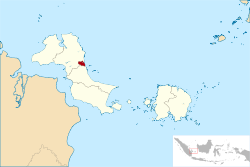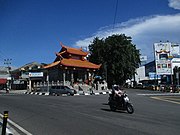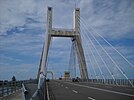Pangkalpinang
Pangkalpinang | |
|---|---|
| City of Pangkalpinang Kota Pangkalpinang | |
| Regional transcription(s) | |
| •Jawi | ڤڠكل ڤينڠ |
| •Chinese | Bang gia tân cảng |
Pangkalpinang city view Fuk Tet Che Temple Wilhelmina Park Emas Bridge Air Anyir Power Plant Batu Bolong Beach Street view | |
| Motto(s): | |
 Location withinBangka Belitung Islands | |
| Coordinates:2°8′S106°7′E/ 2.133°S 106.117°E | |
| Country | |
| Region | Sumatra |
| Province | |
| Founded | 17 September 1757 |
| Government | |
| • Mayor | Maulan Aklil |
| • Vice Mayor | Muhammad Sopian |
| Area | |
| • Total | 104.54 km2(40.36 sq mi) |
| Elevation | 0−13 m (−43 ft) |
| Population (mid 2022 estimate)[1] | |
| • Total | 226,297 |
| • Density | 2,200/km2(5,600/sq mi) |
| Demographics | |
| •Ethnic groups | Malay Javanese Batak, Chinese Bugis[2] |
| • Religion | Islam52.31% Buddhism36.18% Confucianism4.56% Christian3.41% Catholic3.21% Hinduism0.04% Others 0.27%[3] |
| • Languages | Indonesian(official) Chinese Malay English(regional) |
| Time zone | UTC+7(Indonesia Western Time) |
| Area code | (+62) 717 |
| Vehicle registration | BN |
| Website | pangkalpinangkota.go.id |
| Pangkalpinang | |||||||||||||||||||||
|---|---|---|---|---|---|---|---|---|---|---|---|---|---|---|---|---|---|---|---|---|---|
| Traditional Chinese | Bang gia tân cảng | ||||||||||||||||||||
| Simplified Chinese | Bang gia tân cảng | ||||||||||||||||||||
| |||||||||||||||||||||
Pangkalpinang,also colloquially written asPangkal Pinang,is the capital and largestcityof theBangka Belitung IslandsProvince inIndonesia.It is located onBangka Island's east coast, the city is divided into seven districts (kecamatan) and has 42 wards (kelurahan).
It covers an area of 89.40 square kilometres (34.52 sq mi)[4]and it had a population of 174,838 at the 2010 Census[5]and 218,568 at the 2020 Census;[6]the official estimate as at mid 2022 was 226,297.[1]The city's average population density was about 2,165 per square kilometre in mid 2022. The Rangkui River divides the city into two parts, and Jalan Merdeka is its geographic center.
Pangkalpinang's population consists largely of ethnic Malays and Hakka Chinese people. There are also smaller immigrant communities of other ethnic groups, such asBatakandMinangkabau.Landmarks in the city include the Timah Museum, a Chinese temple, the Cathedral of St. Joseph, the Bangka Botanical Garden, and the Pasir Padi beach.
Etymology[edit]
Pangkalpinang is derived from the local wordspengkal( "base" ) andpinang(Areca catechu,a species of palm tree widely grown on the island of Bangka).
History[edit]
Pre-colonial rule[edit]
As part ofSrivijaya,Pangkalpinang was inhabited by Hindus. In addition to being a territory of Sriwijaya, it was also a territory ofMajapahitand theMataram Kingdom.In all three kingdoms, Pangkalpinang received little attention despite its proximity to international shipping routes and became a hideout for pirates preying on ships in theSouth China Sea
To secure the shipping routes around theStrait of Malacca,theJohor Sultanatesent troops to Pangkalpinang and began spreadingIslamin the region. However, the pirates soon returned.
Years later, in another attempt to rid the area of piracy, theSultan of Bantensent aregentof the Indonesian archipelago to eradicate the pirates. The regent established control and ruled Bangka until his death, when his authority passed to his only daughter.
Colonial rule[edit]
Around 1709,tinwas found on the banks of the Olin River in Toboali District. With the discovery of tin, merchants from China and elsewhere flocked to the region; the Sultan of Palembang sent representatives to China in search of tin experts. In 1717, thePalembang Sultanatebegan developing trade relationships with theDutch East India Company(VOC). With the company's help, the sultan attempted to eradicate piracy and tin smuggling.
The Netherlands was occupied by France at the height of theNapoleonic Wars,and the British seized all areas inNusantaraunder Dutch governance. In accordance with the Tuntang Agreement, on 18 September 1811 the Dutch handed over the island of Java, Timor, Makassar, and Palembang to the British; Pangkalpinang become a British colony.Stamford Rafflessent emissaries to Palembang to take over the Dutch fort in Sungai Aur, but they were rejected by SultanMahmud Badaruddin II.Raffles also demanded the tin mines in Pangkalpinang from Badaruddin.
Raffles sent an expedition to Palembang, led byRollo Gillespie,on 20 March 1812. Gillespie replaced Mahmud Badaruddin II with Prince Adipati, giving him the title of Sultan Ahmad Najamuddin II, and the new sultan handed over the islands ofBelitungandBangka Islandsto the British.
In accordance with theAnglo-Dutch Treaty of 1824,the Netherlands regained areas occupied in 1803 by the British (including Pangkalpinang). The native people were subjected to fraud, extortion, and forced labor by the Dutch and the British. The Dutch exploited the tin reserves; guerrilla warfare was fought inMusi Rawas,and Pangkalpinang fought to expel the Dutch.
DuringWorld War II,Bangka Island wasoccupiedbyJapanesetroops. Although the occupation of Pangkalpinang was brief, shortages of food and clothing were severe.
Independent Indonesia[edit]
After Japan surrendered to theAlliesand theIndonesia proclaimed its independence,Pangkalpinang became part of Indonesia. (initially as part of the province ofSouth Sumatra). After the country's political landscape changed, Bangka Belitung Islands were separated from South Sumatra andcombined as a provincewith Pangkalpinang its capital.
Demographics[edit]

Pangkalpinang's population was 108,411 in 1990, and 174,838 in the 2010 census,[5]rising to 218,568 at the 2020 Census;[6]the official estimate as at mid 2022 was 226,297.[1]Half areMalay,and primarily speakBangka Malay.The remainder areChinese,descendants of 18th-century emigrants fromGuangdongprovince. Locally known asPeranakan(Children of the Indies), they primarily speakHakka;a small community speaksCantonese.TheirendonymisThong Ngin(Đường nhân;'Tang people "'), and other Malays are known asFan Ngin(Phiên nhân;'Malay people "').
Islamis the largest religion. The Chinese primarily adhere toBuddhismandChristianity,with a minority embracingTaoismandConfucianism.
Geography[edit]
Topography[edit]
The city's topography is generally undulating and hilly, with an altitude of 20–50 metres (66–164 ft) above sea level. Hilly areas are primarily in the west and south, including Mount Girimaya (50 metres above sea level) and Tower Hill. A 290-hectare (720-acre) urban forest is in the Old Village area. An area of 1,562 hectares (3,860 acres) is under cultivation for food crops, fisheries and forestry. Fallow land is 1,163 hectares (2,870 acres), and 4,130 hectares (10,200 acres) are developed. The remaining 2,085 hectares (5,150 acres) are swamps and forest.
Geology[edit]
The city's soil has an average pH below 5, with red-yellowpodzolicsoil andregosol.A small area isbogsoil and light-gray regosol derived from the deposition of sand and clay. Although such soil is less suitable for rice, other crops may be grown. The oldest formations arePermo-Carboniferouslimestone,Late Triassicslate and Triassic-Jurassicgranite. Composition of the granitic rocks includes dark-colored (occasionally green)biotiteandamphibole.
Hydrology[edit]
The Rangkui River flows through the city, and the Pedindang River is in the south. They drain into the Baturusa River, which flows to theSouth China Sea.The rivers provided transport to markets, and make Pangkalpinang prone to flooding (especially during the rainy season or at times of high tide).
Climate[edit]
Pangkalpinang has atropical rainforest climate(Af) with heavy rainfall year-round. Rain gets noticeably heavier from November to April.
| Climate data for Pangkalpinang (Depati Amir Airport,1991–2020 normals) | |||||||||||||
|---|---|---|---|---|---|---|---|---|---|---|---|---|---|
| Month | Jan | Feb | Mar | Apr | May | Jun | Jul | Aug | Sep | Oct | Nov | Dec | Year |
| Record high °C (°F) | 34.8 (94.6) |
33.8 (92.8) |
34.3 (93.7) |
34.4 (93.9) |
35.0 (95.0) |
34.4 (93.9) |
34.0 (93.2) |
33.9 (93.0) |
35.9 (96.6) |
36.1 (97.0) |
34.9 (94.8) |
34.4 (93.9) |
36.1 (97.0) |
| Mean daily maximum °C (°F) | 30.2 (86.4) |
30.6 (87.1) |
31.2 (88.2) |
31.6 (88.9) |
31.8 (89.2) |
31.5 (88.7) |
31.3 (88.3) |
31.6 (88.9) |
32.0 (89.6) |
31.9 (89.4) |
31.3 (88.3) |
30.3 (86.5) |
31.3 (88.3) |
| Daily mean °C (°F) | 26.1 (79.0) |
26.3 (79.3) |
26.5 (79.7) |
26.9 (80.4) |
27.5 (81.5) |
27.4 (81.3) |
27.2 (81.0) |
27.4 (81.3) |
27.5 (81.5) |
27.3 (81.1) |
26.8 (80.2) |
26.2 (79.2) |
26.9 (80.4) |
| Mean daily minimum °C (°F) | 23.5 (74.3) |
23.5 (74.3) |
23.6 (74.5) |
23.9 (75.0) |
24.5 (76.1) |
24.4 (75.9) |
24.1 (75.4) |
24.1 (75.4) |
24.1 (75.4) |
24.0 (75.2) |
23.8 (74.8) |
23.5 (74.3) |
23.9 (75.0) |
| Record low °C (°F) | 19.6 (67.3) |
19.0 (66.2) |
19.8 (67.6) |
20.2 (68.4) |
20.4 (68.7) |
21.5 (70.7) |
21.0 (69.8) |
21.0 (69.8) |
21.4 (70.5) |
21.0 (69.8) |
21.1 (70.0) |
19.8 (67.6) |
19.0 (66.2) |
| Averageprecipitationmm (inches) | 284.4 (11.20) |
233.3 (9.19) |
258.9 (10.19) |
244.7 (9.63) |
207.6 (8.17) |
135.4 (5.33) |
131.4 (5.17) |
104.8 (4.13) |
100.3 (3.95) |
169.3 (6.67) |
226.8 (8.93) |
296.1 (11.66) |
2,393 (94.21) |
| Average precipitation days(≥ 1.0 mm) | 18.3 | 13.3 | 16.2 | 15.6 | 14.4 | 11.7 | 10.9 | 7.5 | 7.7 | 11.4 | 16.2 | 19.2 | 162.4 |
| Source:World Meteorological Organization[8] | |||||||||||||
Administrative Districts[edit]
At the time of the 2010 Census, the city was divided into fivedistricts(kecamatan),[5]but two additional districts were created subsequently. These are all tabulated below with their areas and their populations at the 2010 Census[5]and 2020 Census,[6]together with the official estimates as at mid 2022.[1]The table also includes the locations of the district administrative centres, the numbers ofadministrative villages(all classed as urbankelurahan) in each district, and its postal code.
| Kode Wilayah |
Name of District (kecamatan) |
Area in km2 |
Pop'n Census 2010 |
Pop'n Census 2020 |
Pop'n Estimate mid 2022 |
Admin centre |
No. of kelurahan |
Post codes |
|---|---|---|---|---|---|---|---|---|
| 19.71.04 | Rangkui | 5.01 | 39,938 | 35,703 | 36,965 | Keramat | 8 | 33132 - 33139 |
| 19.71.01 | Bukit Intan | 35.68 | 43,325 | 41,343 | 42,805 | Air Itam | 7 | 33147 - 33149 |
| 19.71.07 | Girimaya | 4.35 | (a) | 18,129 | 18,770 | Sriwijaya | 5 | 33141 - 33146 |
| 19.71.03 | Pangkal Balam | 4.74 | 41,055 | 22,141 | 22,925 | Kotapang | 5 | 33111 - 33115 |
| 19.71.06 | Gabek | 20.46 | (a) | 35,013 | 36,251 | Gabek Dua | 6 | 33111 - 33119 |
| 19.71.02 | Taman Sari | 3.22 | 13,117 | 18,473 | 19,126 | Gedung Nasional | 5 | 33121 - 33127 |
| 19.71.05 | Gerunggang | 31.09 | 37,323 | 47,766 | 49,455 | Bukit Merapin | 6 | 33123 - 33125 |
| Totals | 104.54 | 174,838 | 218,568 | 226,297 | 42 |
Notes: (a) the 2010 population of the areas which later became Girimaya and Gabek districts is included in the figures for the districts from which they were cut out.
Attractions[edit]
Nganggung,a food-sharing tradition, is usually performed on religious holidays such asLebaranandEid al-Adha.TheQingming Festival(Ceng Beng,Thanh minh,inHakka Chinese) is also celebrated.
The Tin Museum is Asia's only tin museum, and was the site of the 7 May 1949Roem–Van Roijen Agreementon the future of independent Indonesia. The 1936 Jamik Mosque, in Jalan Masjid Jamik, is one of the largest and oldest mosques in Pangkalpinang. Kwan Tie Miaw temple (Quan đế miếu), on the Jalan Mayor Muhidin, is one of the oldest temples on the island of Bangka. Formerly known as the Kwan Tie Bio Temple, it is estimated to have been built in 1841 and dedicated toLord Guan.GPIB Maranatha, originally the Kerkeraad der Protestansche Gemeente to Pangkalpinang, was built in 1927. After independence, the church's name was changed to Western Indonesian Protestant Church (GPIB) Maranatha Pangkalpinang.[9]
Cuisine[edit]
Tai Fu Sui(Đậu hủ thủy), also known asfu sui(Hủ thủy) is a popular drink similar tosoy milk. Pantiaworkwetiaw(Bàn điều) is made from sago and rice flour and usually served with fish soup.
Transportation[edit]
Angkotsare used in and around the city in lieu of public transit.
Air[edit]
Depati Amir Airportis the airport serving Bangka Belitung, with daily flights toJakarta,Palembang,Tanjungpandan,SurabayaandBatambyGaruda Indonesia,Citilink,Lion AirandSriwijaya Air.A new terminal began operation on 11 January 2017, with an annual capacity of 1,500,000 passengers and an area of 12,000 square metres (3.0 acres).
Sea[edit]
Pangkal Balamis the city's main seaport, providing daily export and import, inter-island trade and passenger transport to and from Jakarta and Tanjungpandan. Smaller seaports, such asMuntok,serves speedboats to and from Palembang.
Economy[edit]
The city's economy is based on agricultural products: food crops, livestock, marine and freshwater fishing and small plantations (rubber, pepper and coconut). Pangkalpinang also has a scenic beach.
Notable residents[edit]
- Artika Sari Devi,Puteri Indonesia 2004,Top 15Miss Universe 2005,actress, model and spokesperson.
- Sandra Dewi,actress and model
- Natasha Mannuela Halim,Miss Indonesia 2016,2nd Runner-UpMiss World 2016,Beauty with a Purposewinner, actress and model
- Sonia Fergina Citra,Puteri Indonesia 2018,Top 20Miss Universe 2018and model
Sister city[edit]
See also[edit]
References[edit]
- ^abcdBadan Pusat Statistik, Jakarta, 2023,Kota Pangkalpinang Dalam Angka 2023(Katalog-BPS 1102001.1971)
- ^Aris Ananta; Evi Nurvidya Arifin; M. Sairi Hasbullah; Nur Budi Handayani; dan Agus Pramono (2015).Demography of Indonesia's Ethnicity.Institute of Southeast Asian Studies dan BPS – Statistics Indonesia.
- ^Data Sensus Penduduk 2010 - Badan Pusat Statistik Republik Indonesia <http://sp2010.bps.go.id/index.php/site/tabel?tid=321&wid=8100000000>
- ^There is a discrepancy with the figures reported by national office of BPS and that reported by the local BPS, which gives 104.54 km2as shown in the table of districts.
- ^abcdBiro Pusat Statistik, Jakarta, 2011.
- ^abcBadan Pusat Statistik, Jakarta, 2021.
- ^Indonesia's Population: Ethnicity and Religion in a Changing Political Landscape. Institute of Southeast Asian Studies. 2003.ISBN9812302123
- ^"World Meteorological Organization Climate Normals for 1991–2020".World Meteorological Organization.Retrieved19 October2023.
- ^"WISATA SEJARAH & PERIBADATAN".
Notes[edit]










